Five new additions to the flora of Andaman & Nicobar Islands, India
L. Rasingam
Botanical Survey of India, Deccan Regional Centre, Hyderabad, Telangana 500048, India
doi: http://dx.doi.org/10.11609/JoTT.o3537.7037-41
Editor: Ravi Prasad Rao, Sri Krishnadevaraya University, Anantapur, India. Date of publication: 26 March 2015 (online & print)
Manuscript details: Ms # o3537 | Received 21 February 2013 | Final received 01 January 2015 | Finally accepted 16 March 2015
Citation: Rasingam, L. (2015). Five new additions to the flora of Andaman & Nicobar Islands, India. Journal of Threatened Taxa 7(3): 7037–7041; http://dx.doi.org/10.11609/JoTT.o3537.7037-41
Copyright: © Rasingam 2015. Creative Commons Attribution 4.0 International License. JoTT allows unrestricted use of this article in any medium, reproduction and distribution by providing adequate credit to the authors and the source of publication.
Funding: Botanical Survey of India, Kolkata.
Competing Interest: The author declares no competing interests.
Acknowledgements: I am grateful to Dr. P. Singh, Director, Botanical Survey of India, Kolkata for facilities, and Dr. P.V. Prasanna, Scientist F, Botanical Survey of India, Deccan Regional Centre, Hyderabad for encouragement. I am also thankful to Mr. K. Sivananthan, Artist, Botanical Survey of India, Southern Regional Centre, Coimbatore for the line drawing and the officials of the Andaman and Nicobar Forest Plantation Development Corporation Limited for field support.

During botanical exploration tours in Little Andaman Island, the author collected five interesting plants, viz., Fioria vitifolia (L.) Mattei (Malvaceae), Combretum acuminatum Roxb. (Combretaceae), Marsdenia tinctoria R. Br. (Apocynaceae), Phoebe lanceolata (Nees) Nees (Lauraceae) and Schoenoplectus mucronatus (L.) Palla (Cyperaceae), which have not been reported earlier from these Islands (Rao 1986; Lakshminarasimhan & Rao 1996; Mathew 1998; Pandey & Diwakar 2008). Hence, these are reported here as additions to the flora of the Andaman and Nicobar Islands. They are enumerated below family-wise with citations, phenology, short descriptions, distribution, habitat and specimens examined with line drawings/photographs to facilitate their easy identification. All the specimens are deposited in the Herbarium of the Botanical Survey of India, Andaman & Nicobar Regional Centre, Port Blair (PBL).
Malvaceae
Fioria vitifolia (L.) Mattei in Boll.Reale Ort. Bot. Giardino Colon. Palermo n.s. 2: 71. 1916; T.K. Paul in B.D. Sharma & Sanjappa, Fl. India 3: 310. 1993. Hibiscus vitifolius L., Sp. Pl. 696. 1753; Mast. in Hook. f., Fl. Brit. India 1: 338. 1874; Philcox in Dassan. & Clayton, Revis. Handb. Fl. Ceylon 11: 303. 1997. (Image 1a)
Specimen examined: 25982 (PBL), 17.v.2008, Quarry Road, Little Andaman Island, India, coll. L. Rasingam (Image 2).
Perennial herbs, ca. 1m high; stem greenish-yellow, terete, pubescent to tomentose with stellate hairs. Leaves simple, alternate, broadly ovate to orbicular, somewhat shallowly to deeply, palmately 3-5- lobed, 2–7x2–6 cm, acute to obtuse at apex, cordate at base, serrate-dentate at margins, chartaceous, glabrescent above, pale green, pubescent with stellate hairs beneath; nerves prominent on both surfaces, stellate hairy; petioles slender, upto 5cm long, pubescent. Flowers axillary, solitary; pedicels ca. 2cm long, articulate just above base. Epicalyx segments ca. 9, linear-lanceolate, ca. 8mm long. Calyx campanulate; lobes 5, ovate, acute, ca. 7mm long. Corolla yellow with dark purple centre, drooping; petals obovate, ca. 3cm long, obtuse at apex, stellate, simple pubescent without. Staminal column deep-purple, ca. 1.5cm long, glabrous, antheriferous throughout; stamens whorled; filaments ca. 1.5mm long. Style arms ca. 4mm long, glandular hairy. Capsules depressed globose, ca. 1.5cm across, beak ca. 3mm long, shallowly winged, adpressed pale yellow setose. Seeds 2-4 in each locule, reniform, ca. 2.5mm across, tubercled, glabrous.
Flowering & Fruiting: January–July.
Distribution: India: Throughout including the Andaman Islands; Myanmar, Thailand, Sri Lanka, Bangladesh, Malaysia and Australia.
Habitat: Occasional along roads, foot paths and waste places.
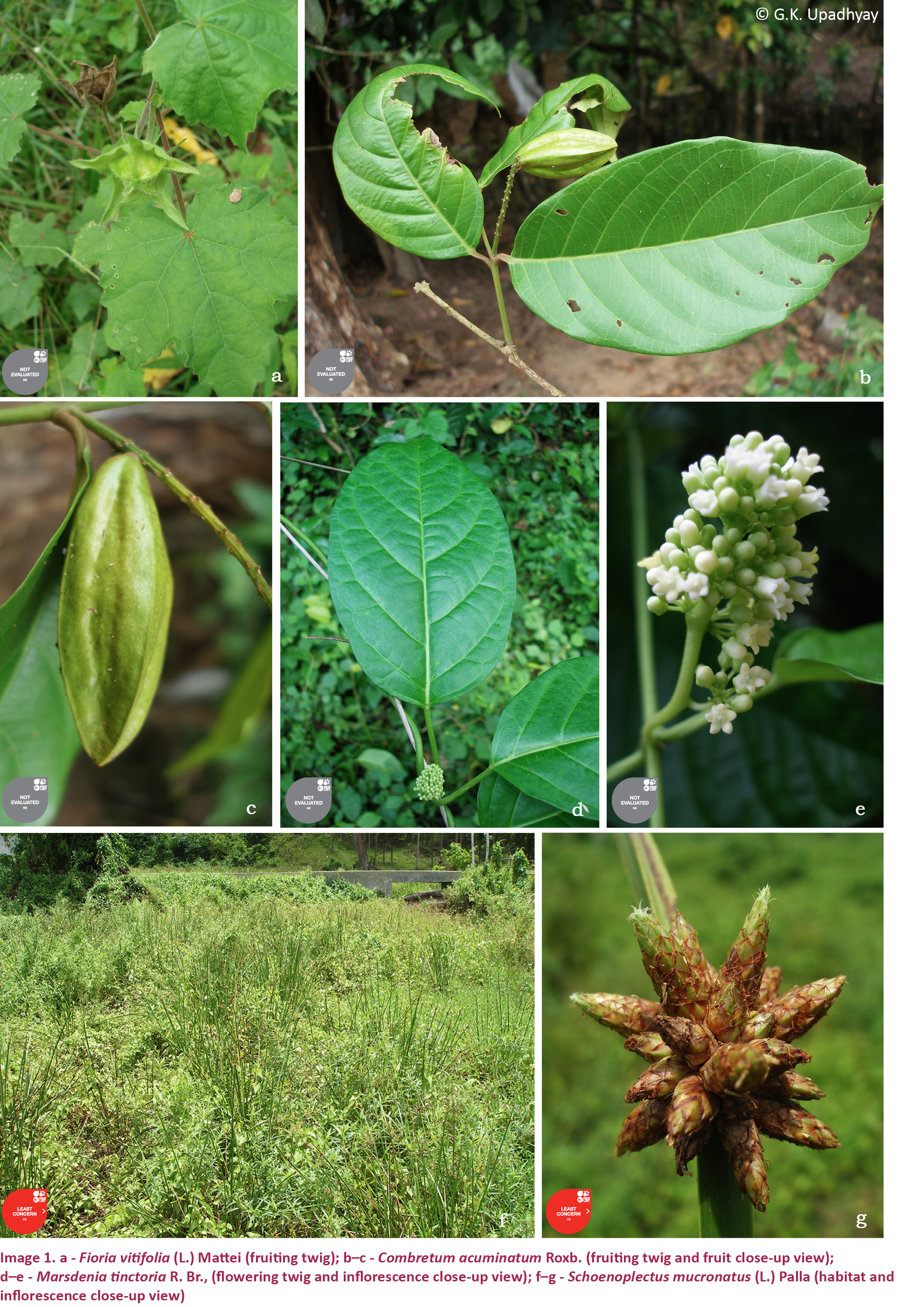
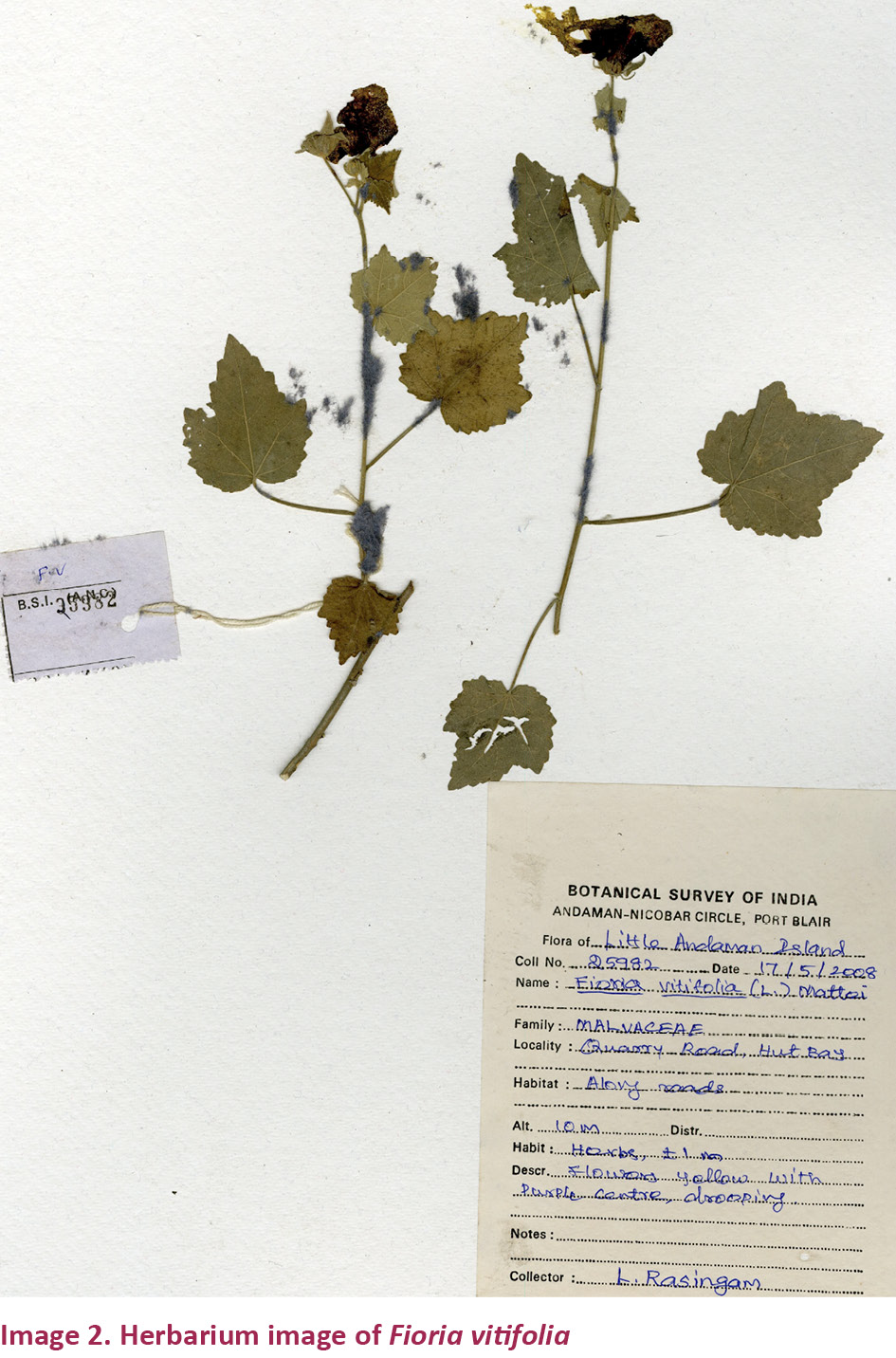
Combretaceae
Combretum acuminatum Roxb., Fl. Ind. (Eds. Carey & Wall.) 2: 228.1824; C.B. Clarke in Hook.f., Fl. Brit. India 2: 455. 1878; Exell in Steenis, Fl. Males., Ser. 1, Spermat. 4: 538. 1954; Backer & Bakh. f., Fl. Java 1: 374. 1963; Stace in Bot. J. Linn. Soc. 105. 1973; Nanakorn in Thai Forest Bulletin 16: 194, t. 83.1986; M. Gangop. & Chakrab. in J. Econ. Taxon. Bot. 21: 299. 1997. Combretum costatum Roxb., Fl. Ind. (Eds. Carey & Wall.) 2: 227.1824; Kurz, Forest Fl. Burma 1: 465. 1877 (Image 1 b–c).
Specimens examined: 25975 (PBL), 16.v.2008, near Sawmill, Nanjappa Nagar, Little Andaman Island, India, coll. L. Rasingam (Image 3).
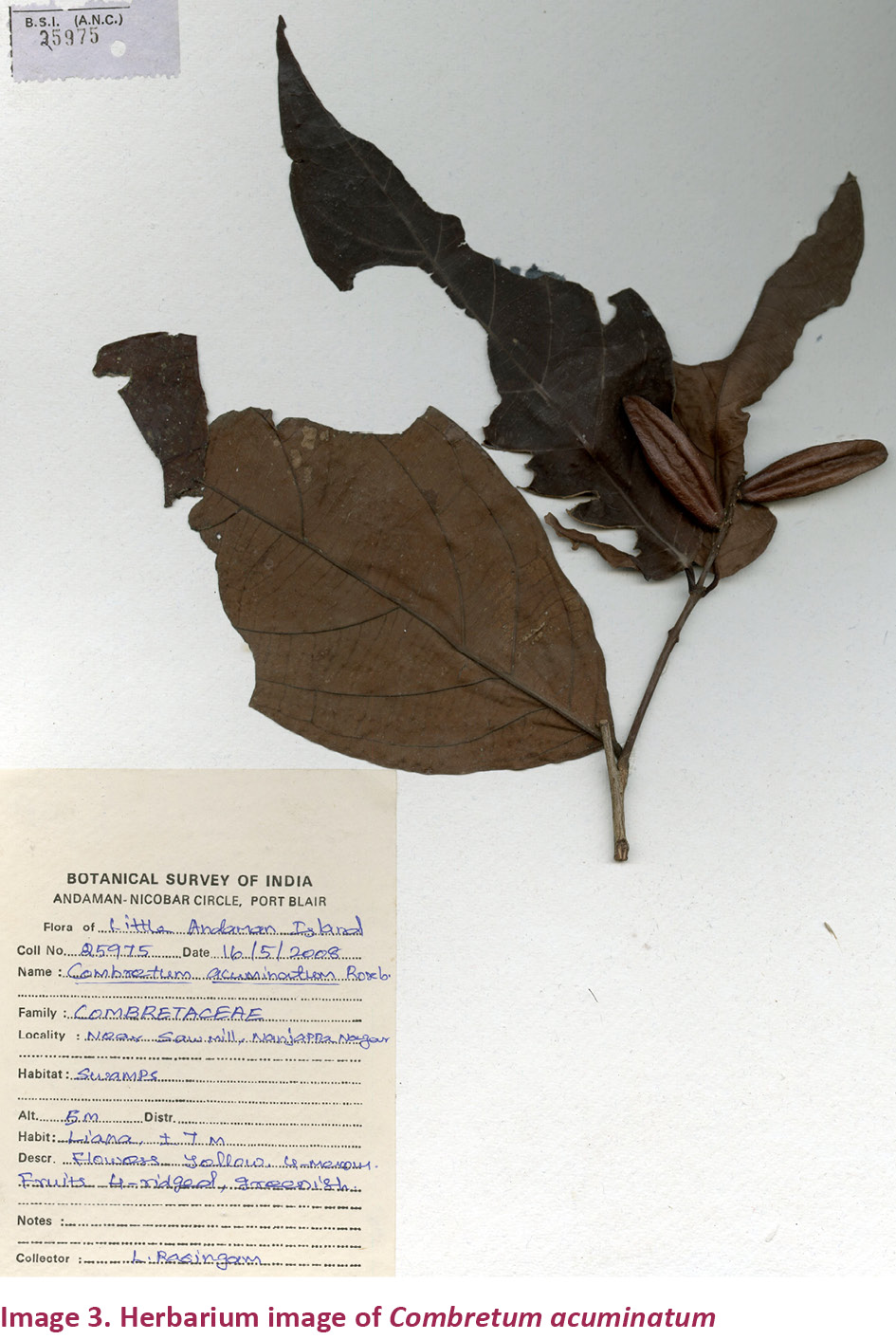
Lianas, up to 7m long; branchlets pale to reddish-brown, obtusely quadrangular, minutely fissured, sparsely to densely lepidote when young, later glabrous. Leaves simple, opposite and sub-opposite, elliptic to oblong-elliptic, rarely ovate, 10–27x5–10.5 cm, acuminate at apex, rounded or cuneate at base, entire along margins,chartaceous, dark reddish-brown, glabrous above, pale brown, glabrous beneath, densely pitted; midrib sunken above, prominent beneath; lateral nerves up to 10 pairs, faint above prominent beneath, secondary nerves scalariform; petioles up to 1cm long, slightly swollen at apex, glabrous. Inflorescence in axillary and terminal spikes, up to 6cm long, densely lepidote. Flowers yellow, 4-merous, cupuliform, ca. 3mm long. Bracteoles linear, ca. 1mm long. Calyx campanulate, ca. 2mm across, densely scaly without, hairy within; calyx lobes ovate, acuminate, ca. 1mm long. Petals linear-oblong, ca. 0.8mm long, glabrous.Stamens ca. 8; filaments filiform, ca. 4mm long. Style ca. 5mm long. Fruit a drupe, sessile, oblong-ellipsoid, 3–4.5x1.5 cm, tapering at both ends, four ridged, ridges c. 5 mm high, brownish, sparsely lepidote.
Flowering & Fruiting: April–June.
Distribution: India: Andaman Islands, northeastern India; Bangladesh, Sri Lanka, Myanmar, Thailand, Indo-China and Malesia.
Habitat: Occasional along the stream banks and waterlogged swampy areas from sea level to 20m.
Apocynaceae
Marsdenia tinctoria R. Br. in Mem. Wern. Nat. Hist. Soc. 1: 30.1811 (1810); Hook.f., Fl. Brit. India 4: 34. 1883; A.P. Jagtap & N.P. Singh, Fasc. Fl. India 24: 134. 1999; Karthik. et al., Fl. Pl. India- Dicot. 1: 176.2009 (Image 1 d–e).
Specimens examined: 25977 (PBL), 16.v.2008, on the way to White Surf Waterfall, Little Andaman Island, India, coll. L. Rasingam (Image 4).
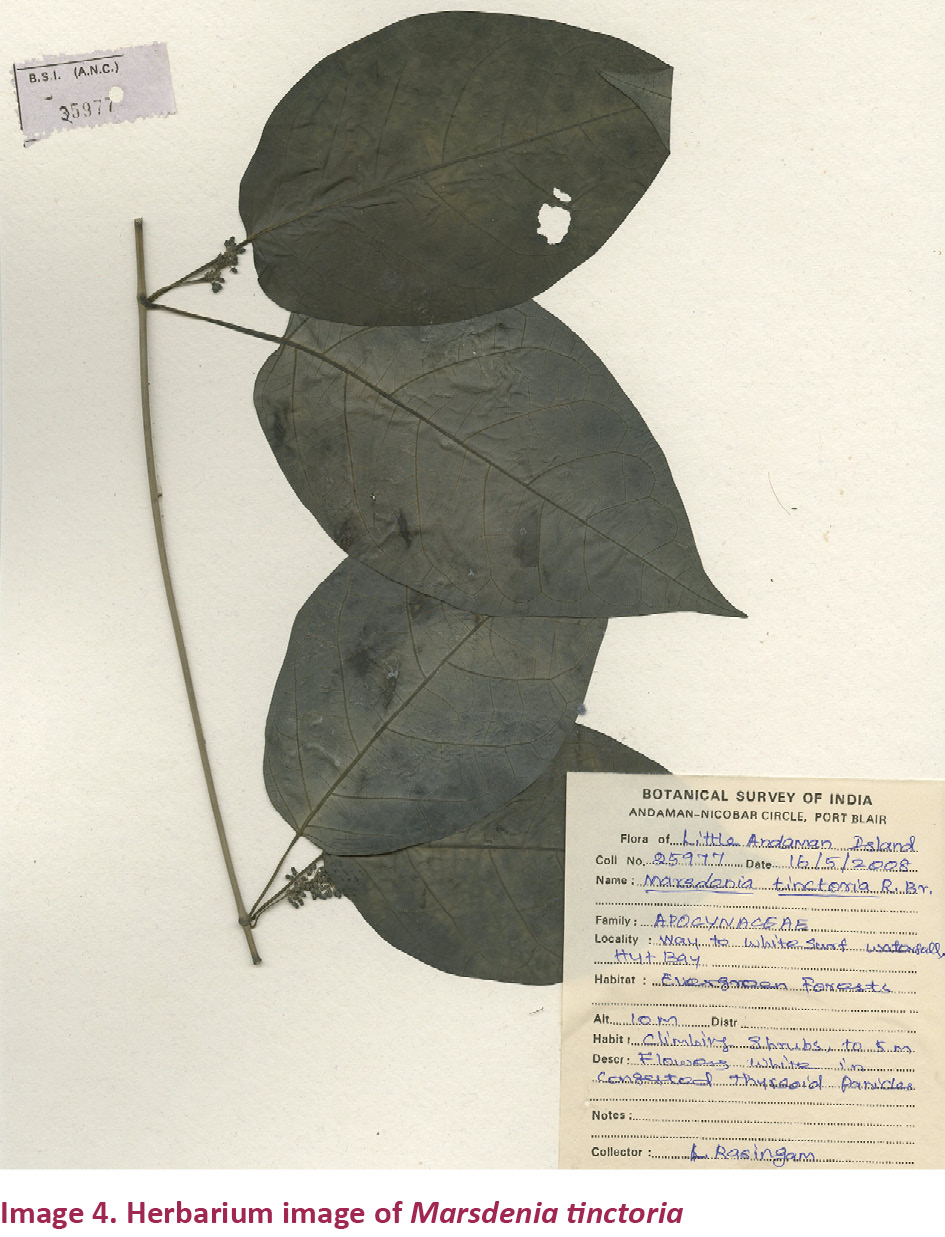
Climbing shrubs, up to 5m high; branches terete, puberulous to glabrous. Leaves simple, opposite-decussate, ovate, 5–15x3–9 cm, acuminate at apex, rounded to truncate at base, entire along margins, ciliate, membranous, glabrous; nerves puberulous on both sides; midrib prominent, flat on both sides; lateral nerves up to seven pairs, prominent on both sides, tertiary nerves scalariform; petioles up to 4cm long, channeled above, puberulous. Inflorescence in axillary, thyrsoid panicles, up to 6cm long, densely flowered; peduncles ca. 3cm long; pedicels filiform, ca. 3mm long. Calyx 5-lobed, divided up to base; lobes ovate, c. 1 x 0.5 mm, acute at apex, ciliate along margins, pubescent without, glandular within. Corolla campanulate, ca. 3mm long; corolla tube ca. 2mm long, glabrous without, ring of hairs at mouth of corolla tube; lobes 5, oblong, 0.5x0.5 mm, obtuse at apex. Corona stamina, uniseriate, 5-lobed. Stamens 5; pollen masses solitary in each anther cell.
Flowering & Fruiting: May–July.
Distribution: India: Andaman Islands, Arunachal Pradesh, Assam, Manipur, Nagaland, Sikkim, Tripura and West Bengal; Nepal, Indonesia and China.
Habitat: Rare along the footpaths of inland evergreen forests from sea level to 110m.
Lauraceae
Phoebe lanceolata (Nees) Nees Syst. Laur.: 109. 1836; Kurz, Forest Fl. Burma 2: 290. 1877;Hook. f., Fl. Brit. India 5: 141. 1886; Gamble, Fl. Madras 2: 860. 1957 (Repr.). Ocotea lanceolata Nees in Wall., Pl. Asiat. Rar. 2: 71. 1831. Laurus lanceolaria Roxb. Fl. Ind. (Ed. Carey) 2:309.1832. Ocotea ligustrina Nees in Wall., Pl. Asiat.Rar. 2: 71.1831 (Fig. 1).
Specimens examined: 25996 (PBL), 20.v.2008, Nethaji Nagar-Krishna Nallah Ghat Road, Little Andaman Island, India, coll. L. Rasingam (Image 5).
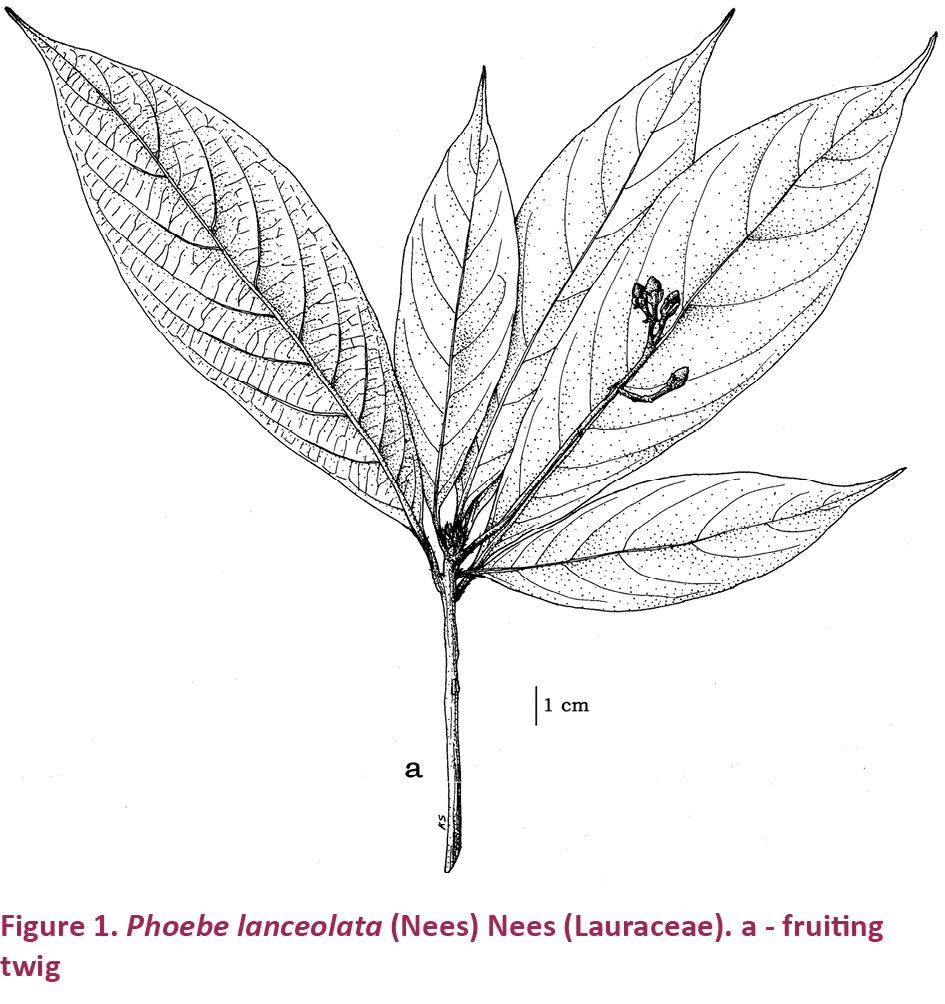
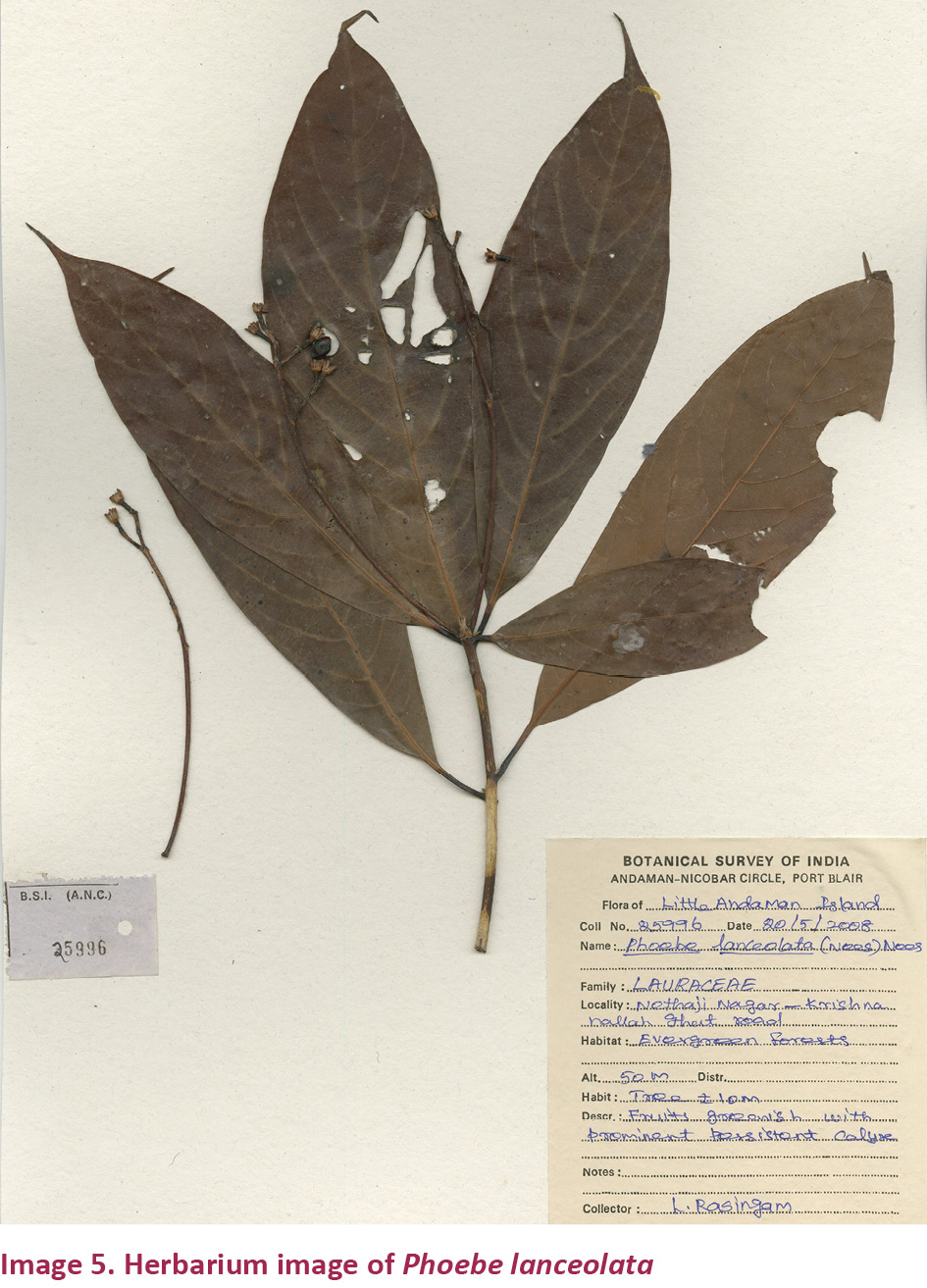
Small evergreen trees, up to 10m high; branchlets slender, glabrous or brown puberulent; buds densely yellowish grey tomentose. Leaves simple, lanceolate or elliptic-lanceolate, 13–22×3–5.5 cm, acuminate or long acuminate at apex, attenuate or decurrent at base, thickly papery, abaxially pubescent when young, glabrous on both surfaces when old; midrib thick, elevated adaxially, lateral nerves 9–13 pairs, slender but conspicuous, tertiary nerves invisible on both surfaces; petioles 1–2.5 cm long, glabrous. Inflorescence in axillary panicles, 12–15 cm long; pedicel as long as perianth, glaucous, glabrous. Flowers pale green or yellowish green, 3–4 mm long. Perianth lobes subequal, ovate, 2.5–3 mm long, glabrous outside, grey-white pubescent inside. Anther filaments grey-white pubescent at base, those of 3rd series with sessile glands at base. Ovary glabrous. Fruits ovoid, 9–12×6–7 mm, fruiting pedicel slightly thickened; persistent perianth lobes straw-yellow, leathery, clasping base of fruits.
Flowering & Fruiting: April–June.
Distribution: India: Andaman Islands, Peninsular India, northeastern India; Nepal, Myanmar, Thailand, Indo-China, Malay Peninsula, Indonesia and China.
Habitat: Rare in the inland evergreen forests from sea level to 110m.
Cyperaceae
Schoenoplectus mucronatus (L.) Palla in Bot. Jahrb.Syst. 10: 299.1889; Karthik. et al. Fl. Ind. Enum. Monocot.: 69.1989; D.A. Simpson & T. Koyama in Fl. Thailand 6(4): 276. 1998. Scirpus mucronatus L., Sp. Pl. 50. 1753; C.B. Clarke in Hook. f., Fl. Brit. India 6: 657. 1893; Ridl., Fl. Malay Penins. 5: 161. 1925; Kern in Reinwardtia 6: 33. 1961 & in Steenis, Fl. Males., Ser. 1, Spermat. 7: 510, t. 30. 1974 (Image 1 f–g).
Specimens examined: 25990 (PBL), 18.v.2008, on the way to Nethaji Nagar, Little Andaman Island, India, coll. L. Rasingam.
Perennial herbs, ca. 70cm high; rhizome short, horizontal; stem stout, erect, tufted, triquetrous with concave sides, smooth. Leaves reduced to membranous, brownish bladeless sheaths, ca. 11cm long, acute with a mucro tip. Inflorescence pseudolateral, capitate with 4–16 spikelets, ca. 4cm across. Involucral bracts 1, erect, later deflexed, ca. 5cm long, triquetrous. Spikelets sessile, ovate or oblong, ca. 2.2x0.4 cm, terete, acute, reddish-brown when mature. Glumes tightly appressed, concave, ovate or broadly ovate, mucronate, ca. 3.5x2.5 mm, minutely ciliate along upper margin, many-nerved, pale brown. Perianth segments 6, unequal, longer than nut, retrorsely scabrid. Stamens 3, ca. 2.5mm long; anthers linear, ca. 1.2mm long. Stigmas 3. Nutlets broadly obovate, dorsiventrally compressed, trigonous, ca. 1.9x1.6 mm, shiny blackish-brown, transversely wrinkled.
Flowering & Fruiting: Throughout the year.
Distribution: India: Throughout including the Andaman Islands; widely distributed from South Europe and Africa, Malaysia, Indonesia, Philippines, Papua New Guinea and Australia.
Habitat: Common in swamps, ditches and paddy fields.
References
Lakshminarasimhan, P. & P.S.N. Rao (1996). Supplementary list of angiosperms recorded (1983–1993) from Andaman and Nicobar Islands. Journal of Economic and Taxonomic Botany 20: 175–185.
Mathew, S.P. (1998). A supplementary report on the flora and vegetation of Bay Islands, India. Journal of Economic and Taxonomic Botany 22: 249–272.
Pandey, R.P. & P.G. Diwakar (2008). An integrated checklist of plants in Andaman & Nicobar Islands, India. Journal of Economic and Taxonomic Botany 32: 403–500.
Rao, M.K.V. (1986). A preliminary report on the angiosperms of Andaman and Nicobar Islands. Journal of Economic and Taxonomic Botany 8: 107–184.